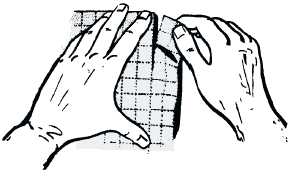| |
individual should be placed across the flap of the
envelope and the envelope dated with the APDS.
Each clerk should be assigned a separate cashbox
or safe when in custody of any portion of the
command’s fixed credit.
Military postal clerks having custody of funds and
stock can be held liable for their loss when they do not
comply with handling and storing instructions. NEVER
allow another Postal Clerk (junior or senior) to sell or
make window transactions from your cash drawer.
Combinations to safes used to store funds and
stock should be changed:
Upon initial receipt of the safe
Whenever there is a compromise of the
combination
Whenever an individual who has had custody of
the combination is transferred or relieved of
credit
Annually
ARRANGEMENT OF STOCK
Any workable arrangement of stamp stock,
consistent with security and protection standards, is
permissible.
The following procedures may prove
helpful to you in arranging your stamp stock.
For convenience keep the stamps in a large
scrapbook, the pages of which are slightly larger
than the sheets of stamps.
Place individual
denominations between the pages in numerical
order, or in order of the most frequently sold
stamps. Tab the pages with each denomination.
Keep stamps flat.
Use a book, a piece of
cardboard or flat metal, or any other heavy object
to keep the stamps from buckling and curling. In
humid climates and during the summer, it may
be helpful to place sheets of waxed paper
between the sheets of stamps to prevent them
from sticking together.
Your stamp drawer will have compartments for
coins and bills.
Place the coins in the front
compartment where they will be accessible to you for
making change.
Place the bills in the large
compartments. If space is available, keep your books
of stamps in the stamp drawer also.
Keep your envelopes and stamped cards in a large
compartment near your stamp window. Never open
more than one box of a kind at a time; when your stock
is audited, unopened boxes are much easier to count.
You will sell stamps over a counter or through a
window, depending upon the size and layout of your
post office. In many offices the counter may serve as
both the stamp window and parcel post counter.
SELLING STAMPS
Postal counter work is one of the most important
tasks you will perform. This type of duty is essentially
one of public contact, and it requires businesslike
behavior and service that is COURTEOUS and
EFFICIENT.
A thorough knowledge of postal
regulations concerning the types of postal services
offered and the appropriate postage rates is a must.
Always remember to collect the money before
handing out the stamps. You should keep the money
handed to you in sight until the transaction has been
completed.
This will avoid any confusion or
disagreement between you and the customer about the
amount you were given. After you have made change,
count it out to the customer.
This will serve to
double-check your computation. You should complete
all necessary postal financial transactions in the
presence of the customer.
When you are selling stamps, especially those for
use on a package, always use those of the highest
suitable denomination. For example, don’t use eight
$.25 stamps when two $1 stamps would suffice. Do not
damage or soil your stamp stock. Sell your older stock
first to minimize spoilage.
SEPARATING AND DELIVERING STAMPS
Before separating a sheet of stamps, crease them
on the lines along which you will separate.
Then
separate along the perforations, being careful not to
tear any stamps. Start at the top and tear down (see
figure 8-1). Separating from bottom to top usually
results in stamps becoming torn.
8-4
PCf0801
Figure 8-1.—Separating stamps.
|

